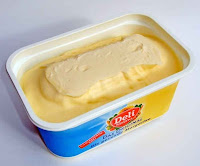Margarine | agriculture commodities - food sciences | Margarine was first invented in France by a chemical expert named Hippolyte Mege-Mouries in 1869. The discovery of margarine is actually triggered by the situation in France at the time where the price of butter is very expensive so many people who can not afford it. This happens as a result of the influence of industrial revolution where a lot of farmers who left the farm and go for the city and work in industries. Consequently, there is a shortage of production so the price of butter became expensive because of high demand. To overcome this situation then in 1869 Napoleon III as ruler of France at that time held a contest and will give prizes to anyone who can find a cheap butter substitute, a replacement would have properties such as butter. Hippolyte Mege-Mouries won the competition because he was able to find what is desired by Napoleon III is a cheap substitute for butter. Mege-Mouries named his invention with margarine, the name is derived from Greek words "margarites" that have meaning "pearl". Named the pearl because the fat of margarine when forming dense granules shaped like a shiny crystal of pearls.
The characteristics of margarine that stands out is more plastic, solid at room temperature, a bit hard at low temperature, texture is easily applied, and quick to melt in mouth.
Margarine divided into table margarine and kitchen margarine . For the kitchen margarine is not required the addition of vitamins A and D. Margarine is an emulsion-shaped food products in the oil-water mixture, which is about 16 percent of water in at least 80 percent vegetable oil or fat. Fat phase is generally composed of vegetable oils, some of which have been compacted in order to obtain the desired plastic properties of the final product.
Margarine was originally made from animal fat but now exclusively made only from plant oils. Margarine practically have a calorific value equivalent to the butter, easy to digest, usually equipped with vitamins A and D. Margarine vegetable has long been recommended as a substitute for butter because they contain unsaturated fat and less cholesterol. According to one study published in the Journal of the American Medical Association, replacing butter with margarine in the diet significantly lowers blood cholesterol levels.
Margarine was originally created by converting the unsaturated fats (hydrocarbon double bond) becomes saturated (single bond) through the process of hydrogenated. Saturated fats are fats that form the crystal plays an important role in determining the texture of margarine and make it stay solid at room temperature. However, the incomplete hydrogenation process are not resulting the formation of trans fatty acids which can raise the level of LDL cholesterol and depress HDL .[ agriculture commodities | food sciences ]


No comments:
Post a Comment